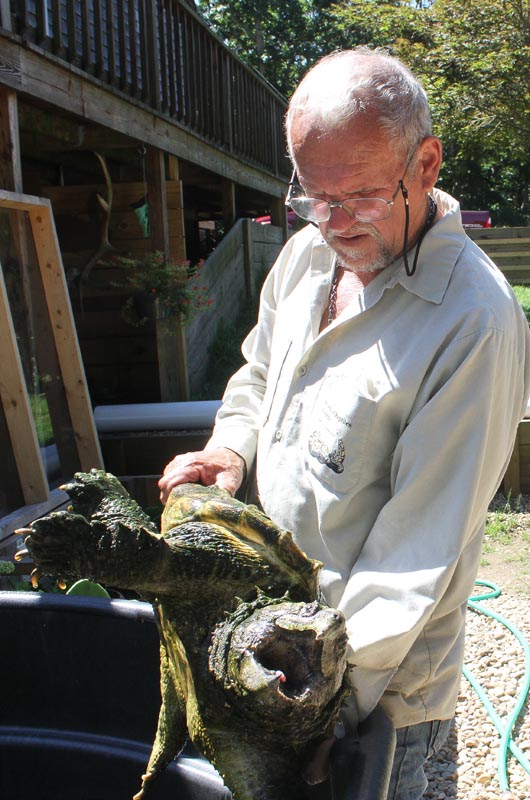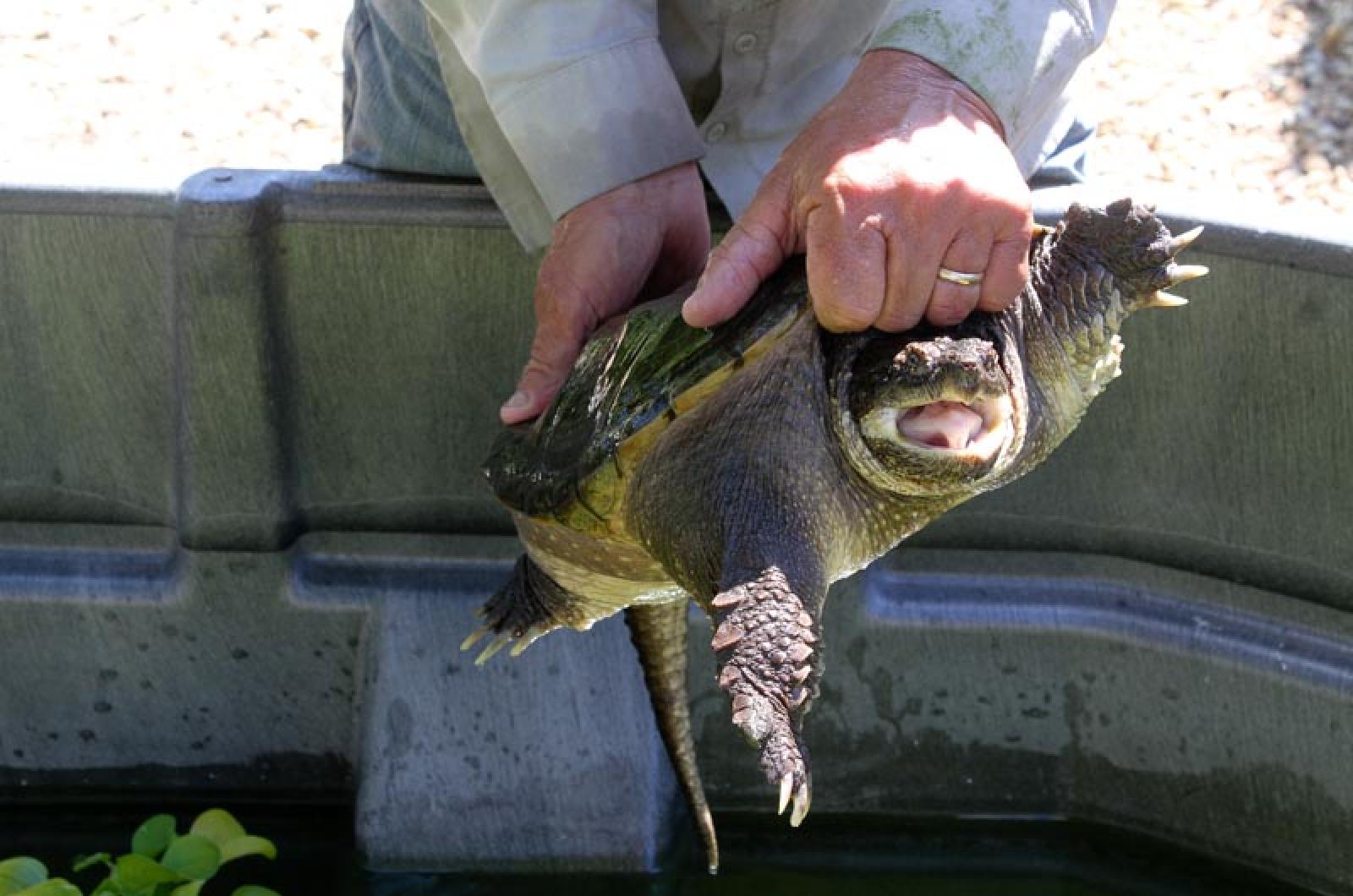Unlike their smaller relatives, snapping turtles don’t bask in the sun or float in rows on logs. They are both predators and scavengers — opportunists who have mastered the art of survival. They are also very large, and almost mythic in the exaggerated tales they inspire.
“Whenever I give talks, somebody inevitably says, ‘there was one, it bit a broomstick in half, it chased our boat and bit the oar,’” said naturalist Gus Ben David. “Nothing could be further from the truth.”
Mr. Ben David caught his first snapping turtle when he was a young boy growing up on the Vineyard. He’s had them ever since, and they were a staple at his World of Reptiles and Birds park, which closed last year. Throughout his career, Mr. Ben David has dedicated himself to educating people about the natural world, fostering appreciation and dispelling tall tales. The snapping turtle is a prime candidate for both goals.
It’s true, Mr. Ben David said, that they can be dangerous. But that’s only when they’re on land, feeling exposed and settling into defensive mode. Then they will rely on their primary mechanism for warding off threats: biting.

“It’s a temperament change,” Mr. Ben David said. “They’re out of their element.”
A basic misunderstanding of how snapping turtle anatomy works contributes to the potential for turtle danger. At first glance, the turtle’s neck looks squat and short, tucked away inside the shell. And yet it is actually much longer, and able to snap, hence the name, out at lightning speed to grab prey. Depending on the size of the turtle, they can extend their necks out about a foot.
“The neck is pretty much the most impressive thing about them,” said Felix Neck Wildlife Sanctuary director Suzan Bellincampi, noting that the snapping turtle is in general a very impressive animal.
Their snap mechanism serves them well when hunting, too. A snapping turtle can sneak up on unsuspecting fish, other turtles, or a floating brood of ducklings. Snappers are not picky about the types of meat they eat.
“That’s just nature’s way,” Mr. Ben David said. “That’s how it works.”
And it has worked for the turtle for millions of years. Like horseshoe crabs and sharks, turtles are relics from another era.
“Without changing their body plan at all, turtles have observed the rise of birds and mammals,” Vern Laux wrote in a 1996 Gazette column. “They are still here today, waiting to see what happens to us.”
“They have this ancient feeling,” said Ms. Bellincampi. She said kids who visit the sanctuary are sometimes afraid of the resident snappers because of their size. But they also love them, “because they look like dinosaurs.” Snapping turtles have a small underbelly shell called a plastron, and as a result their legs appear long for their body. Their tails are studded with spikes, just like a Stegosaurus.
“Each one is the product of millions of years of genetics,” Mr. Ben David said. “So when you look at them, they’re a wonder.”
Nesting season is when most people see snapping turtles on land. On the Vineyard this occurs from late May through June. The females will roam up to a half mile from their home ponds in search of the perfect nesting site. Once a female laid eggs in the Felix Neck compost pile. That turned out to be an imperfect site as the eggs dried out.
Watching the life cycle of snapping turtles is one of the perks of being at Felix Neck, Ms. Bellincampi said.
“You see it happening, and you can watch it and figure it out,” she said. The young are “tiny little things,” she said, but immediately recognizable as snapping turtles because of their ridged carapaces.
When a baby snapping turtle hatches from its nest, it is alone in the world. As with most reptile species, the parents have no involvement with raising their young. Babies are subject to predation from the ground (skunks, raccoons) and the sky (hawks), and most won’t make it. But they’ll nevertheless make a beeline for their home pond as soon as they emerge.
How exactly can a just-hatched creature know where it’s supposed to be going?
“It’s one of nature’s great mysteries, like the herring returning,” Mr. Ben David said. “They’ll head almost in a straight line for the pond.”
They must also teach themselves how to swim. When snapping turtles are young, a major mortality factor is drowning.
But once they do learn, they are “graceful as a ballet,” Mr. Ben David said. Yet few people see the turtle in its element, sculling and turning throughout the water. It’s easier to see them swimming in clear ponds, like Seth’s Pond and Ice House Pond, but the turtles know when people are in their areas and will avoid any contact by retreating into the mud.
“I know of no one getting bit by a snapping turtle in the water, no matter what the old timers say,” Mr. Ben David said.
Young male snapping turtles can also be spotted on land, as they travel in search of new homes after being driven out of a pond by older, more dominant males. As male turtles grow up, they become territorial and fight over their turf. Younger ones must find their own plots of pond to call their own.
The largest snapping turtle recorded in the wild was a 76.5 pound animal caught near Orange, Mass. But for a time, Mr. Ben David owned the largest specimen in New England, a 50-pounder named Big Al.
“I’m not big on names,” Mr. Ben David said. “I don’t like to anthropomorphize.” But he named the turtle after the man who caught it, Albert Fischer 3rd. Mr. Fischer found the turtle in a stream near Squibnocket Pond. When Big Al was caught, he weighed 40 pounds.
Big Al went on the road often with Mr. Ben David, attending lectures and classes as a prime representative of his species. He was equally popular at World of Reptiles and Birds. Big Al was the favorite animal of the late Jacqueline Onassis, Mr. Ben David said. Bill Clinton was also a fan. Big Al died this past winter, but his large shell is still on display.
When Mr. Ben David leads classes, he always demonstrates the proper way to pick up a snapping turtle, in case people want to move one from the road, or catch-and-release a young one without being injured themselves. Never by the tail, he said. The best way is to put one hand at the front of the shell, just behind the head where the neck can’t reach around and snap, and one at the back, above the tail. Another way is to pick them up laterally, holding the turtle with both hands towards the back of the body, out of reach of the head again, and taking care to avoid swipes from the turtle’s claws. In any case, be prepared for the sheer heft of the turtle.
Mr. Ben David has two snapping turtles at his home who travel with him now that Big Al is gone. He also has two alligator snapping turtles — distant relatives from the Southeast. They are the biggest freshwater turtle species in the world, potentially reaching a weight of up to 300 pounds. One of Mr. Ben David’s alligator turtles is 20 years old and was 60 pounds at last check, but “might be more.”
“I haven’t weighed him yet this summer,” Mr. Ben David said.
Alligator snapping turtles don’t have the long necks that their cousins do, and can’t rely on lightning speed to catch prey. Instead, they let prey come to them. They have a small pink appendage on their tongue that resembles a worm. Fish swim right into the turtle’s mouths to check it out, and they get eaten themselves.
“It’s an incredible strategy,” Mr. Ben David said.
Like the common snapping turtle, alligator snapping turtles prefer to stay hidden, burrowed in the mud and keeping to themselves. In both cases, it’s hard to get accurate population counts because of the animal’s general reclusive nature. Still, Mr. Ben David estimates that just about every freshwater pond on the Island has a snapper of its own living there.
“Absolutely,” he said. “You may not think so, but they’re there.”







Comments (7)
Comments
Comment policy »